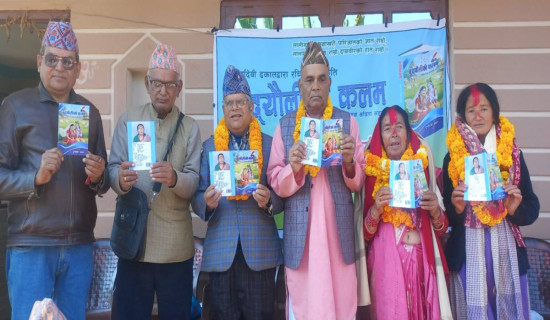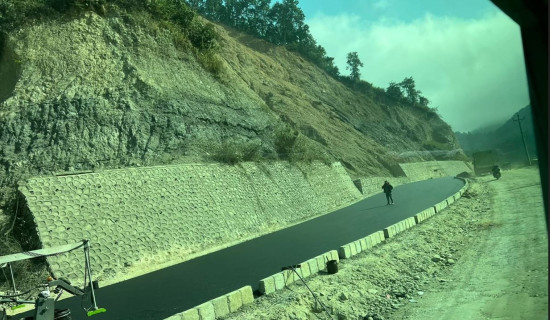- Sunday, 14 December 2025
Enable Local Levels To Manage Disasters
Nepal’s disaster management is mainly guided by the Constitution of Nepal and the Disaster Risk Reduction and Management Act, 2017. The constitution’s schedule 7 assigns the responsibilities of disaster management as a shared priority of the federal and provincial governments; schedule 8 describes as the sole responsibilities of the local governments; and schedule 9 assigns it as the shared priority to all level of governments. Thus, all the levels of government are responsible for disaster management. However, this write-up will particularly focus on the role of local government in Disaster Risk Reduction and Management (DRRM) and will present the ways to make local governments more responsible to manage disasters locally up to their optimum capacity as envisioned by the spirit of the constitution.
As the closest political unit accountable to citizens, every local government has first-hand knowledge of social, economic, infrastructure and environmental needs of its community. Likewise, it has better access to indigenous knowledge and greater access to population at risk. Furthermore, section 11(2) of the Local Government Operation Act, 2017 has also assigned authority to make own laws, policies and guidelines related to disaster management. Therefore, the local levels are first port of call on the disaster management. Global commitment on DRRM, such as the Sendai Framework for Disaster Risk Reduction 2015-2030 also sets targets for local government’s preparedness for disaster management.
Local governments are gradually understanding and internalising their role in DRRM. However, in many cases, actual implementation of disaster related responsibilities on the ground has remained limited and ineffective. In order to make resilient local level that has the capacity to mitigate the major disruptions and to bounce back quickly from the adversity through the effective build back better mechanism, the LGs should consider the major four aspects.
Specific problems
First, the municipal or village council is vested with the power to make their own laws as per their needs. Every local government has its own specific problems as they have different geological, hydro-meteorological, socio-cultural and economic conditions. So are their financial and technical capacity. But the law related to DRRM is just copied from the model law provided by the federal government without the comprehensive analysis of the local context. Thus, such laws drafted on ad hoc basis fail during implementation. Legislative capacity of local government is not viable enough to exercise the vested power to formulate laws in the extended jurisdiction.
Secondly, disaster management has not received adequate priority in local planning and decision-making process. Local representatives have a mindset of just responding to the disaster rather than developing the long-term mitigation and preparedness measures such as hazard zonation, identification of vulnerable group, specification of relocation area and installation of early warning systems. Local governments seem to prioritise the purchase of fire engines and ambulance over disaster mitigation measures. Likewise, Local Disaster Management committees are not proactive and their responsibility is just limited to distributing relief materials to disaster-affected people.
Thirdly, our local governments still have the traditional human resource management practices. Human resource is the key to the enactment of local disaster management Acts and policies. But LGs lack the human resources that can contribute to disaster management by collecting data, developing mitigation tools and conducting risk assessment. Most of the local governments have DRRM focal person without the relevant academic background and practical skills of disaster management.
Fourth, there are the problems of corruption, mismanagement, and lack of transparency in the utilisation of funds and resources allocated for disaster recovery and rehabilitation. There are issues of coordination and accountability among various agencies and organisations that collaborate with LGs in disaster response and relief. The people still consider natural calamities as acts of certain divine entities. So, poverty and lack of awareness is hitting the poorest and the most fragile communities of LGS.
Ways forward
LGs need to be aware of the fact that disaster management is their important responsibility. In fact, a comprehensive legislative framework is required for the LGs to make the practical laws and policies for DRRM. They should develop their own plans by specifying local risks, needs and response option with due consultation, scrutiny and examinations. Proper identification of the areas where LGs can perform autonomously and the areas where they need coordination and the assistance from the province and federal government is of the utmost importance. LGs need to assign enough funds for disaster management with clear specification of where and how they should be spent. Likewise, skilled DRRM focal person and cluster staff members with clear authority and job description should also be in priority.
Mitigation is the cornerstone of DRRM as it substantially reduces the cost of disaster management and minimises the loss. LGs must collaborate with each other to share and optimise the resources so that the unaffected local level can assist those hit by the disaster. The prevailing international practice stresses the concept of three 'R's of disaster management- Reduce risk minutely; respond locally and recover immediately. The LGs should embrace these ideas. Finally, integrating the indigenous knowledge, boosting public participation and empowerment of the vulnerable groups such as women, children and the elderly in DRRM is the key step towards building resilient local government.
(The author is a section officer of the Government of Nepal.)
















